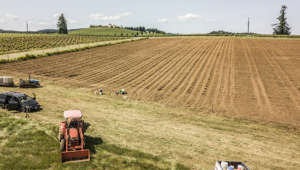On the winding drive up to King Estate Winery, visitors first pass an orchard of plum and apple trees before coming upon the old rootstock nursery on the left. Over the years the nursery has shrunk as King Estate has transitioned out of that service, and now some of that acreage is being planted with a Pinot Noir clone that is unusual in Oregon and brand new to King Estate.
Oregon is famous for Pinot Noir, of course, and King Estate has always been a bit of a maverick by planting almost twice as much Pinot Gris as Pinot Noir. That ratio shifted a titch when grafts of the Mount Eden clone, known as Clone 37, were planted recently on two acres of Block 9A just beyond the nursery. An additional acre may be planted next year.

Although the estate already boasts quite a bit of clonal diversity, Director of Viticulture Raymond Nuclo is always on the lookout to add to the mix, with early ripening clones of special interest due to climate change. In addition to being early to ripen, the Mount Eden clone is appealing for its smaller berries with concentrated flavor and intensity.
Vineyard Manager Meliton Martinez, who has been with King Estate from the start, describes how the new vines came to be, beginning with cuttings from a nursery and ending with vines growing in the fields.
The cuttings arrive on the estate in January where they are put in cold storage to remain dormant. In April the cuttings are individually bench-grafted onto American rootstock to fuse the two together. American rootstock is insect tolerant and helps the grafted vine survive and grow healthy grapes.
Demonstrating the process, Mel begins with a piece of the rootstock. He strips off the buds and then matches the diameter of the rootstock to that of a cutting of Pinot Noir. Using a tool that looks like a cross between a vise and a giant stapler, he grafts the two pieces together, making the joint nearly invisible. The grafts are then stored in a humid, 85-degree callusing room. After two to three weeks in this warm environment, a callus will have formed all around the graft union. At that point the grafts are taken out and the joint is sealed with wax so the young tissue doesn’t dehydrate.

In early June workers placed about 2,000 of these young plants in the soil of Block 9A. The first grapes will be harvested in 2020 or 2021, with the wines from these vintages released some two or three years after that.
Bench grafting is the most commonly used type of grafting, but there are other techniques for introducing new vines onto the estate that we will address in a future blog. In the meantime, we’ll keep you posted on the progress of our new Mount Eden Pinot Noir.
